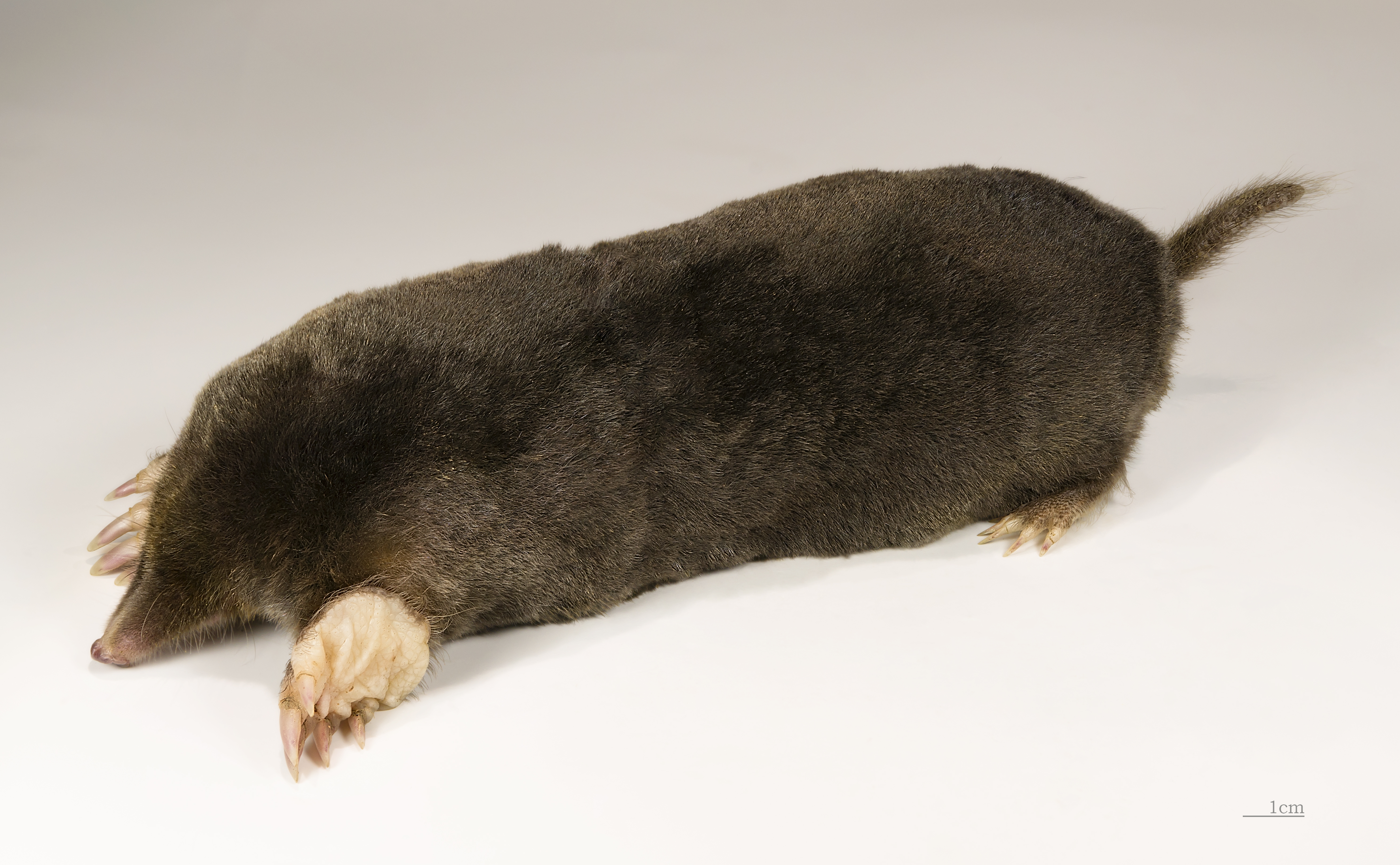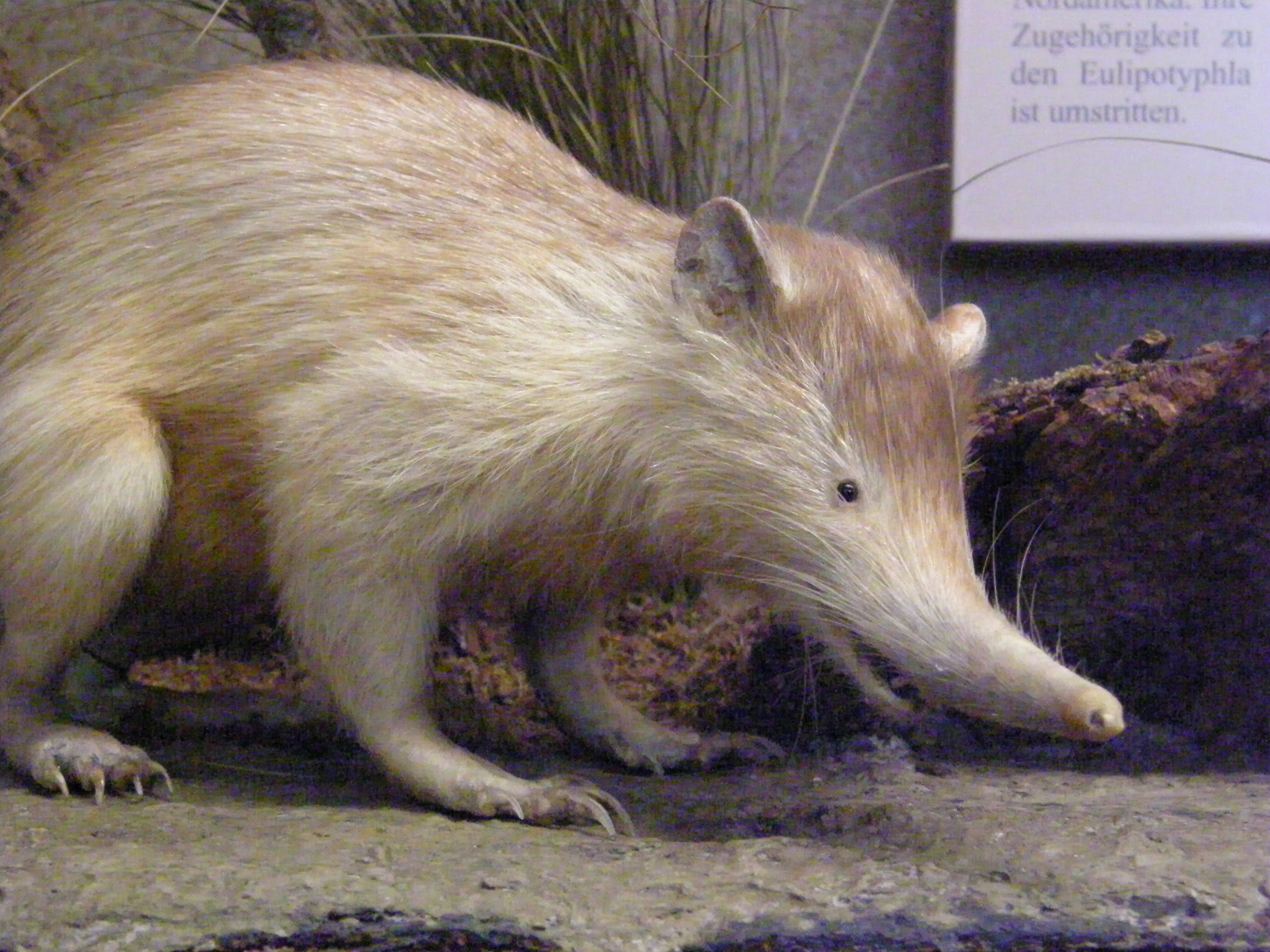|
Nesophontidae
''Nesophontes'', sometimes called West Indies shrews, is the sole genus of the extinct, monotypic mammal family Nesophontidae in the order Eulipotyphla. These animals were small insectivores, about 5 to 15 cm long, with a long slender snout and head and a long tail. They were endemic to the Greater Antilles (except Jamaica), in Cuba, Hispaniola (now the Dominican Republic and Haiti), Puerto Rico, the United States Virgin Islands, and the Cayman Islands. Extinction Although reliable estimates are unavailable, these animals are confirmed to have survived the Pleistocene extinction, since remains have been found among those of ''Rattus'' and ''Mus'' species. Some authorities estimate extinction coinciding with the arrival of rats aboard Spanish vessels in the early 16th century (1500). Others, such as Morgan and Woods, claim that some species survived until the early 20th century. A phylogenetic study in 2016, based on DNA extracted from a specimen about 750 years old, suggests ... [...More Info...] [...Related Items...] OR: [Wikipedia] [Google] [Baidu] |
Eulipotyphla
Eulipotyphla (, which means "truly fat and blind") is an order of mammals suggested by molecular methods of phylogenetic reconstruction, which includes the laurasiatherian members of the now-invalid polyphyletic order Lipotyphla, but not the afrotherian members (tenrecs, golden moles, and otter shrews, now in their own order Afrosoricida). Eulipotyphla comprises the hedgehogs and gymnures (family Erinaceidae, formerly also the order Erinaceomorpha), solenodons (family Solenodontidae), the desmans, moles, and shrew-like moles (family Talpidae) and true shrews (family Soricidae). True shrews, talpids and solenodons were formerly grouped in Soricomorpha; however, Soricomorpha has been found to be paraphyletic, since erinaceids are the sister group of shrews, and they are more closely linked to the Carnivora order; (such as cats, dogs, bears, skunks, badgers, etc.). It is the sister clade of Scrotifera; together, they make up Laurasiatheria. Classification * Order Eulipoty ... [...More Info...] [...Related Items...] OR: [Wikipedia] [Google] [Baidu] |
Solenodon
Solenodons (from el, τέλειος , 'channel' or 'pipe' and el, ὀδούς , 'tooth') are venomous, nocturnal, burrowing, insectivorous mammals belonging to the family Solenodontidae . The two living solenodon species are the Cuban solenodon (''Atopogale cubana''), and the Hispaniolan solenodon (''Solenodon paradoxus''). Threats to both species include habitat destruction and predation by non-native cats, dogs, and mongooses, introduced by humans to the solenodons' home islands to control snakes and rodents. The Hispaniolan solenodon covers a wide range of habitats on the island of Hispaniola from lowland dry forest to highland pine forest. Two other described species became extinct during the Quaternary. Oligocene North American genera, such as '' Apternodus'', have been suggested as relatives of ''Solenodon'', but the origins of the animal remain obscure. Two genera, '' Atopogale'' and '' Solenodon'', are known, each with one extant species. Other genera have b ... [...More Info...] [...Related Items...] OR: [Wikipedia] [Google] [Baidu] |
Nesophontes Paramicrus
The St. Michel nesophontes (''Nesophontes paramicrus'') is an extinct species of mammal in the family Nesophontidae. It was endemic to Hispaniola (today Haiti and the Dominican Republic). Taxonomy A phylogenetic study in 2016, based on DNA extracted and carbon-dated from a specimen about 750 years old, suggests their nearest relatives are the solenodons, although the two groups diverged more than 40 million years ago. History The type specimen was collected in Cueva de Bosque Humido, Los Haitises National Park Los Haitises National Park is a national park located on the remote northeast coast of the Dominican Republic that was established in 1976. It consists of a limestone karst plateau with conical hills, sinkholes and caverns, and there is a large ar ..., Hato Mayor Province, Dominican Republic. References Nesophontes Holocene extinctions Mammals of Hispaniola Extinct animals of the Dominican Republic Mammals of the Dominican Republic Mammals of Haiti Mammals ... [...More Info...] [...Related Items...] OR: [Wikipedia] [Google] [Baidu] |
Nesophontes Hypomicrus
The Atalaye nesophontes (''Nesophontes hypomicrus'') is an extinct species of mammal in the family Nesophontidae. It was endemic to Hispaniola in the Caribbean (in both Haiti and the Dominican Republic), and is only known from fossil A fossil (from Classical Latin , ) is any preserved remains, impression, or trace of any once-living thing from a past geological age. Examples include bones, shells, exoskeletons, stone imprints of animals or microbes, objects preserved ... deposits. References Nesophontes Holocene extinctions Extinct animals of Haiti Extinct animals of the Dominican Republic Mammals of the Dominican Republic Mammals of Haiti Mammals of Hispaniola Mammals of the Caribbean Mammals described in 1929 Taxonomy articles created by Polbot Mammal extinctions since 1500 {{eulipotyphla-stub ... [...More Info...] [...Related Items...] OR: [Wikipedia] [Google] [Baidu] |
Nesophontes Micrus
The western Cuban nesophontes (''Nesophontes micrus'') is an extinct species of mammal in the family Nesophontidae. It was found on Cuba and Hispaniola Hispaniola (, also ; es, La Española; Latin and french: Hispaniola; ht, Ispayola; tnq, Ayiti or Quisqueya) is an island in the Caribbean that is part of the Greater Antilles. Hispaniola is the most populous island in the West Indies, and th .... It was recently discovered to include three previously thought species: ''N. submicrus'', ''N. longirostris'', and ''N. superstes''. References Nesophontes Holocene extinctions Extinct animals of Cuba Extinct animals of Haiti Mammals of the Caribbean Mammals of Cuba Mammals of Haiti Taxonomy articles created by Polbot Taxa named by Glover Morrill Allen {{eulipotyphla-stub ... [...More Info...] [...Related Items...] OR: [Wikipedia] [Google] [Baidu] |
Nesophontes Zamicrus
The Haitian nesophontes (''Nesophontes zamicrus'') is an extinct species of mammal in the family Nesophontidae. It was endemic to Hispaniola in the Caribbean (in both the Dominican Republic and Haiti Haiti (; ht, Ayiti ; French: ), officially the Republic of Haiti (); ) and formerly known as Hayti, is a country located on the island of Hispaniola in the Greater Antilles archipelago of the Caribbean Sea, east of Cuba and Jamaica, and ...). References Nesophontes Mammals of Haiti Mammals of the Caribbean Extinct animals of Haiti Mammals described in 1929 Taxonomy articles created by Polbot Mammal extinctions since 1500 {{eulipotyphla-stub ... [...More Info...] [...Related Items...] OR: [Wikipedia] [Google] [Baidu] |
Cayman Islands
The Cayman Islands () is a self-governing British Overseas Territory—the largest by population in the western Caribbean Sea. The territory comprises the three islands of Grand Cayman, Cayman Brac and Little Cayman, which are located to the south of Cuba and northeast of Honduras, between Jamaica and Mexico's Yucatán Peninsula. The capital city is George Town on Grand Cayman, which is the most populous of the three islands. The Cayman Islands is considered to be part of the geographic Western Caribbean Zone as well as the Greater Antilles. The territory is a major world offshore financial centre for international businesses and wealthy individuals, largely as a result of the state not charging taxes on any income earned or stored. With a GDP per capita of $91,392, the Cayman Islands has the highest standard of living in the Caribbean. Immigrants from over 130 countries and territories reside in the Cayman Islands. History No archaeological evidence for an in ... [...More Info...] [...Related Items...] OR: [Wikipedia] [Google] [Baidu] |
Quaternary Extinction Event
The Quaternary period (from 2.588 ± 0.005 million years ago to the present) has seen the extinctions of numerous predominantly megafaunal species, which have resulted in a collapse in faunal density and diversity and the extinction of key ecological strata across the globe. The most prominent event in the Late Pleistocene is differentiated from previous Quaternary Turnover-pulse hypothesis, pulse extinctions by the widespread absence of ecological succession to replace these extinct species, and the regime shift of previously established faunal relationships and habitats as a consequence. The earliest casualties were incurred at Eemian, 130,000 BCE (the Eemian, start of the Late Pleistocene), in Australia (continent), Australia ~ 60,000 years ago, in Americas ~ 15,000 years ago, coinciding in time with the early human migrations. However, the great majority of extinctions in Afro-Eurasia and the Americas occurred during the transition from the Pleistocene to the Holocene epo ... [...More Info...] [...Related Items...] OR: [Wikipedia] [Google] [Baidu] |
Rattus
''Rattus'' is a genus of muroid rodents, all typically called rats. However, the term rat can also be applied to rodent species outside of this genus. Species and description The best-known ''Rattus'' species are the black rat (''R. rattus'') and the brown rat (''R. norvegicus''). The group is generally known as the Old World rats or true rats and originated in Asia. Rats are bigger than most Old World mice, which are their relatives, but seldom weigh over in the wild. Taxonomy of ''Rattus'' The genus ''Rattus'' is a member of the giant subfamily Murinae. Several other murine genera are sometimes considered part of ''Rattus'': '' Lenothrix'', '' Anonymomys'', '' Sundamys'', '' Kadarsanomys'', ''Diplothrix'', '' Margaretamys'', ''Lenomys'', '' Komodomys'', ''Palawanomys'', '' Bunomys'', '' Nesoromys'', ''Stenomys'', '' Taeromys'', '' Paruromys'', '' Abditomys'', '' Tryphomys'', '' Limnomys'', '' Tarsomys'', ''Bullimus'', ''Apomys'', ''Millardia'', ''Srilankamys'', '' Niviv ... [...More Info...] [...Related Items...] OR: [Wikipedia] [Google] [Baidu] |
Mus (genus)
The genus ''Mus'' or typical mice refers to a specific genus of muroid rodents, all typically called mice (the adjective "muroid" comes from the word " Muroidea", which is a large superfamily of rodents, including mice, rats, voles, hamsters, gerbils, and many other relatives). They are the only members of the tribe Murini. However, the term mouse can also be applied to species outside of this genus. Subgenera, species, and subspecies '' The following is a list of ''Mus'' subgenera, species, and subspecies: *'' Coelomys'' **'' Mus crociduroides'' (Sumatran shrewlike mouse) **''Mus mayori'' (Mayor's mouse) **''Mus pahari'' (Gairdner's shrewmouse) **''Mus vulcani'' (volcano mouse) *''Mus'' **'' Mus booduga'' (Little Indian field mouse) **'' Mus caroli'' (Ryukyu mouse) **'' Mus cervicolor'' (Fawn-colored mouse) ***''Mus cervicolor cervicolor'' ***''Mus cervicolor popaeus'' **'' Mus cookii'' (Cook's mouse) **'' Mus cypriacus'' (Cyprus mouse) **'' Mus famulus'' (Servant mouse) **' ... [...More Info...] [...Related Items...] OR: [Wikipedia] [Google] [Baidu] |
Spain
, image_flag = Bandera de España.svg , image_coat = Escudo de España (mazonado).svg , national_motto = '' Plus ultra'' ( Latin)(English: "Further Beyond") , national_anthem = (English: "Royal March") , image_map = , map_caption = , image_map2 = , capital = Madrid , coordinates = , largest_city = Madrid , languages_type = Official language , languages = Spanish , ethnic_groups = , ethnic_groups_year = , ethnic_groups_ref = , religion = , religion_ref = , religion_year = 2020 , demonym = , government_type = Unitary parliamentary constitutional monarchy , leader_title1 = Monarch , leader_name1 = Felipe VI , leader_title2 = Prime Minister , leader_name2 = Pedro Sánchez , legislature = ... [...More Info...] [...Related Items...] OR: [Wikipedia] [Google] [Baidu] |
Quaternary
The Quaternary ( ) is the current and most recent of the three period (geology), periods of the Cenozoic era (geology), Era in the geologic time scale of the International Commission on Stratigraphy (ICS). It follows the Neogene Period and spans from 2.58 million years ago to the present. The Quaternary Period is divided into two epochs: the Pleistocene (2.58 million years ago to 11.7 thousand years ago) and the Holocene (11.7 thousand years ago to today, although a third epoch, the Anthropocene, has been proposed but is not yet officially recognised by the ICS). The Quaternary Period is typically defined by the cyclic growth and decay of continental ice sheets related to the Milankovitch cycles and the associated climate and environmental changes that they caused. Research history In 1759 Giovanni Arduino (geologist), Giovanni Arduino proposed that the geological strata of northern Italy could be divided into four successive formations or "orders" ( it, quattro ord ... [...More Info...] [...Related Items...] OR: [Wikipedia] [Google] [Baidu] |





